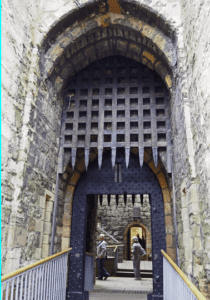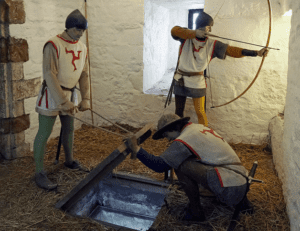Entry is through the barbican and outer gatehouse which has the ticket office and a small shop. (Don’t bother with the guide book – it is poor.)
A doorway leads into the main ward, a grassy area between the keep and the curtain wall. Derby House is on the right, but is not open or visitors as it is still the law court for the south of the island. The main ward contained stables, brewery, blacksmith, workshops and a mint in the C18th. Nothing is left of these buildings.
Stone steps lead up to the curtain wall with its walkway. Near them, steps lead down into the dungeon. The remains of the foundations of a small chapel can still be seen. This was built by the seventh Earl of Derby as it was more convenient for the family living in Derby House to use this than the original chapel at the top of the keep.
The inner gatehouse leading into the keep once once had a deep pit in front of it, crossed by a drawbridge but this has been filled in and it is reached up a ramp. The two portcullises are still there. Between them, in the roof are three murder holes. Above is another guard room.
The ground floor guardrooms on either side of the gatehouse entrance were used as prison cells in the C18th. Bishop Wilson was imprisoned in one of them in 1722 following a dispute with the lieutenant General. A model of the Bishop is displayed in his cell, working on a translation of the Bible into Manx.
Inside the keep is a large central courtyard with a well and open fireplace. Stone steps lead up to rooms on the first floor.
The ground floor of the keep has display boards with history of the castle. The upper floors were originally accessed by spiral staircase. The metal and stone stairway referred to as the ‘Prison Stairs’ was added later. Pictures of the Stanley Lords of Man with their coats of arms are hung on the walls.
Some of the rooms in the keep are furnished as they might have been in the in the C16th and C17th. Off the main rooms are smaller rooms which were prison cells in the C18th and these now contain information boards.
The two main rooms on the first floor are furnished as they might have appeared in the C17th when the Earls of Derby were the Lords of Mann. The main room with its red and gold wall hangings and red velvet chair of estate was the Presence Chamber and is the most impressive room in the keep. C17th visitors reached it by the external staircase from the courtyard.
Next to it is the Lord’s private dining room, a small dark room with green and purple wall hangings. Off is a small garderobe.
On the opposite side of the presence chamber are the kitchens with cobbled floors and a large open fireplace. Food hangs from the ceiling and there are beer barrels and a few shelves for storage.
The rooms on the second floor are furnished as they might have been in the C15th. The Lord’s great chamber is basically furnished with a few wooden chests. The walls are hung with painted linen cloths, which provided protection against cold and damp. They were cheaper than tapestries and could be painted with images specifically related to the family.
The small room off the great chamber is the treasury, which was the most secure place in the castle. Valuables and documents were stored here.
The King’s dining room has wall hangings with jousting scenes. The three small windows are lined with velum, making the room very dark. Only the select few, like the Bishop of Rushen Abbey, would be entertained here. For other occasions, the first floor hall (now the presence chamber) would have been used. Benches were used apart from the King and most important guests who had chairs. Food was placed on the table for guests to serve themselves. On very special occasions, roast peacock would be served, with its skin and feathers sewn back on after cooking.
The small rooms off were used as prison cells in the C18th.
A spiral staircase leads up to the keep ramparts with views of Castletown and the surrounding area.
In the south tower was the Medieval chapel, which now houses the clock mechanism and weights. The clock is dated 1597, and is unusual as it just has one hand. It is thought to have been a gift from Elizabeth I.
Other rooms contain information about the history of the castle, personalities and the prison years. Allow plenty of time for a visit as there is so much to see and read.
There is more information about Castletown “here.”:http://wasleys.org.uk/eleanor/man/south/castletown/index.html









